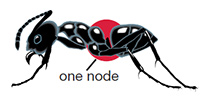The key to ant management lies in proper identification and thorough treatments
By DR. ELRAY ROPER
Ants can be extremely difficult to manage because they are resilient and adept at finding niches where they can thrive. One key to successful ant management is proper identification. Once you know what ant species you are trying to manage, it is easier to put together an ant management program. The following outline should help you identify the ant species that are often the biggest pests for customers.
Ants can be divided into two groups: those with one node and those with two nodes. The segment between an ant’s thorax and abdomen is called a pedicel and has either one or two segments called nodes.
Ant species with only one node include: 
- Argentine ants
- Carpenter ants
- Crazy ants
- Ghost ants
- Odorous house ants
- White-footed ants
Ant species with two nodes include:

- Fire ants
- Pharaoh ants
- Little black ants
- Pavement ants
There are four key elements of an effective ant program that will help make management simpler and more successful:
- Thorough inspection: Inspect for ants both indoors and outdoors. Pay close attention to foliage, exterior cracks, gaps, entryways and wet areas that could be a source of food or water.
- Indoor treatment: It is sometimes necessary to treat trails of foraging ants indoors, such as areas around doors and windows. These trails and their surrounding areas can be spot-treated with an insecticide. If trails are located indoors, an ant gel bait can be used in cracks and crevices in areas where ants have been seen.
- Outdoor baiting and spot treatments: Offer an alternative food source by applying an ant gel bait near the foraging trails outside of a structure. For spot treatments, drench ant colonies with a liquid insecticide. Inspect landscape ornamentals that are close to the home. Soil or foliar treatments with a systemic insecticide, such as Tandem® insecticide or Optigard® Flex insecticide, can manage honeydew-producing insects that feed on the landscape ornamentals. Eliminating ant food sources, such as honeydew-producing insects, can also eliminate the ant population.
- Perimeter application: A perimeter treatment can be helpful when ants are trailing from an adjacent structure. A large-volume application of an insecticide that can be diluted and applied at high volumes can provide comprehensive coverage, resulting in more thorough management.
By following these four steps and utilizing the broad range of products Syngenta offers, you can win the battle against invading nuisance ants. For more detailed instructions on ant identification and management, download the ANTSwers brochure from Syngenta.

©2017 Syngenta. Important: Always read and follow label instructions. Some products may not be registered for sale or use in all states or counties. Please check with your local extension service to ensure registration and proper use. For Life Uninterrupted™, Optigard®, Tandem® and the Syngenta logo are trademarks of a Syngenta Group Company. Syngenta Customer Center: 1-866-SYNGENT(A) (796-4368).
Dr. ElRay Roper is Senior Technical Representative for Syngenta Professional Pest Management.
PMP’s Direct To You provides pest management professionals with educational refreshers on timely and critical topics essential to operational success. This content is not be used as a substitute for obtaining legal advice from an attorney licensed to practice where you live. Look for the content-rich PMP Direct To You archives at mypmp.net/direct-to-you-archive.
|